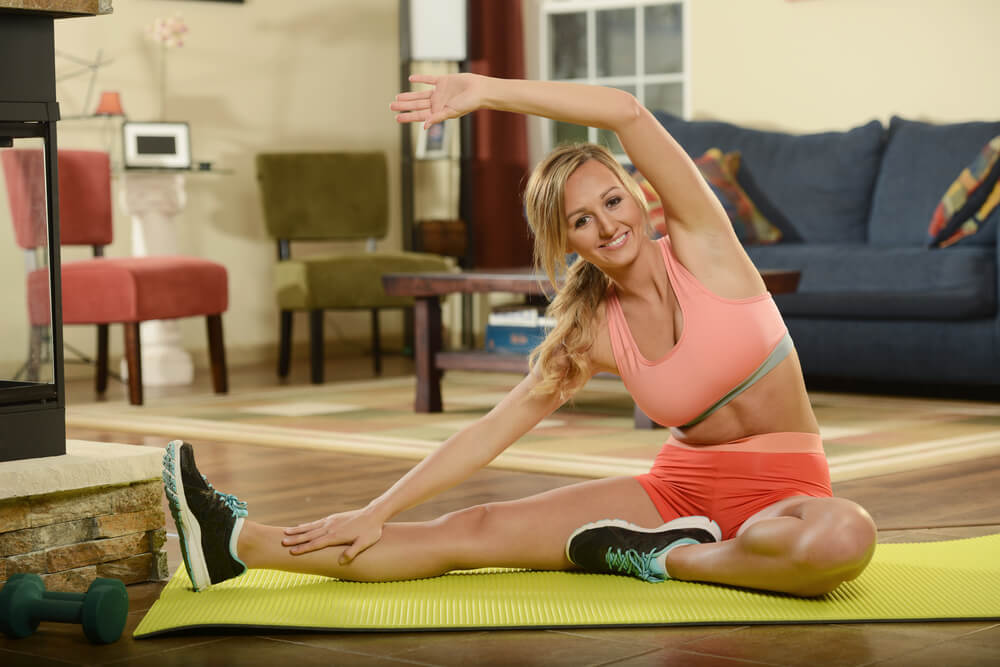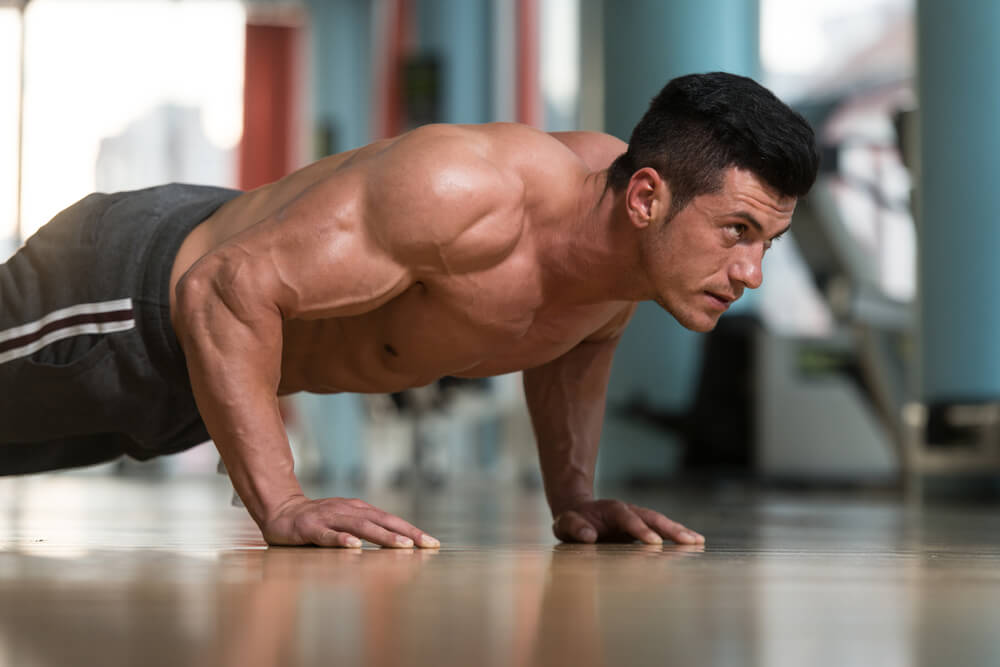
You don’t need to go to the gym. You can build lean muscle at home. Want to know how? We’ve got a Home muscle building workout sure to lead to muscle gains.
What’s one of the key advantages of an at home muscle building workout?
It can be done without weights by using only your body for resistance, which is sometimes referred to as calisthenics. People used to assume that you had to use weights to create enough resistance to gain muscle, but this is only true when it comes to bulk muscle.
Lean gains, on the other hand, can be accomplished with a bodyweight workout routine.
There are hundreds of social media videos showing men and women who started off small and increased their muscle mass simply be doing bodyweight exercises. This, of course, took time because the human body can only gain a maximum of 2.5 pounds of lean muscle per month.
But, with proper training and nutrition, you can build 24 pounds of muscle or more each year. And, the best news is that because the gains are lean muscle, you won’t have to do a cutting cycle to burn fat.

How Bodyweight Resistance Works
Bodyweight resistance works as a muscle building workout because you are moving your body and creating contractions that cause muscle stimulation. There are other techniques where you cause even more resistance such as negatives or taking weight from one side of your body. That will be explained more in depth later.
The point is that you don’t only get resistance by pumping weights.
Your body has no idea what you are using. You may think about the weights and look at them, but your muscles have no clue what is going on. All they know is something causes them to contract with enough intensity to encourage muscle growth.
Some feel that you can do a basic bodyweight workout without any rest days since it isn’t that intense. That isn’t always true.
Yes, you could perform a set of crunches, pull-ups, squats and push-ups all on the same day and never need to take a rest day. But, if you’re trying to increase lean muscle mass, then you need to do them at higher intensities beyond a single set.
In this case, you would definitely need to take a rest day for your muscles to repair.
Do You Have To Target Specific Muscle Groups?
You usually would not need to target specific muscle groups as most of the exercises revolving around bodyweight training target multiple muscle groups. There really is not much you can do for some muscles, such as your biceps or triceps when you aren’t using equipment.
The only options you should focus on are either dividing your upper and lower body into two separate workouts or doing a full body workout. Either would be fine, but the training program in this article is going to focus on a full body workout being used three or four days a week.
Doing a full body workout allows you to keep the intensity high to not only increase strength and lean muscle growth but also to encourage muscle endurance and fat loss.
Lean muscle gains focus on burning fat while you increase your body’s muscles. This means you have to increase the intensity by taking shorter breaks after several exercises.
The idea of shorter or fewer rest breaks is to keep your body moving. Long rest breaks are to allow your muscles time to regenerate force to move heavy resistance.
But, you are using your body, not weights, and have no need for this. Push through the exercises and keep your heart rate going. This alone will help burn the extra calories and strengthen your heart.

What Kind Of Exercises Do I Have To Choose From?
You have a lot of exercises you can choose from depending on what you want to do for the day. Usually, they are all variations of the most popular calisthenics such as push-ups, pull-ups, squats, planks, crunches, etc.
Each one can have a twist added to it that causes more intensity than the regular version.
For example, during the push-ups, you can lift one foot off the floor and maintain this throughout the set. Then you switch feet and repeat. This creates extra resistance because you are throwing your body off balance causing your upper body to contract harder along with your core muscles.
You could even change the elevation of your body such as with canyon push-ups. This exercise is when your palms are on a higher level than your feet. It allows you to lower your chest even further.
Don’t worry. Your lower body is not left out of this. You can get your core and stabilizer muscles in an uproar by doing squats on one leg or doing frog hops instead to encourage power in your legs.
There are too many different types of exercises to list. The point is that you are not just stuck with six or seven exercises to choose from.
Isometric Training
Isometric training is a bit different from what you normally think when it comes to training. Usually, we associate muscle contractions with movement. But the truth is that your muscles contract by simply holding a position for a set amount of time.
Isometric exercises are ones where you do not perform movements unless you are switching positions. Think about how you flex your muscles and hold them in that position. The most common ones you likely see the most are planks and wall sits.
The plank is one to note because studies consistently show that this exercise, when done right, is using 100% of your abs region to complete the exercise. This, of course, makes it the best abs exercise to do and the reason why it became so popular in the first place.
Yes, it is a great core training exercise, but the intent behind it was for abs contractions via an isometric standpoint.
You definitely want to add a few isometric exercises into your training program. They keep the intensity while at the same time allowing you to breathe a little before carrying on to your next exercise. The plank is the most versatile because there are lots of variations for it such as side planks.
Jumping Movements
Athletes often do jumping exercises. The reason is because they build up muscle endurance and the ability to burst through with power. For example, a basketball player will usually be conditioned with exercises such as frog hops, wall touches, and vertical squats.
Why?
The reason is because they help to develop the burst power in their legs. This allows them to jump higher.
Many people do not think about doing these exercises. Let’s face it: Non-athletes don’t usually do these.
It’s definitely something to consider including in your routine and one or two will be added in this home workout program.

Home Muscle Building Workout Program
This is going to be a full body workout that you can do three or four days a week. This gives you proper rest day cycling. The three-day workout allows you to have two consecutive days off. The four-day plan has you in a train, rest and repeat cycle.
The choice is yours as to how many times you wish to train during the week.
Each exercise is only done once per round. This means you keep moving on to the next exercise until it states you need to take a rest. You will cycle through the workout at least twice, and then carry on to adding another round when ready.
The workout program could be done for however long you wish, but you should consider switching exercises in and out after about three or four months to keep your body from developing a routine. You will be given the exercise and reps to do for each of them.
You may only be able to do one round at first.
Exercise Reps
Squat x25
Bulgarian Split Leg Squat x20 (each side)
Lunge (alternating as moving) x20 (each side)
Vertical Squat Jump x15
Wall Sit Hold 30 to 60 seconds
Rest for 30 Seconds.
Push-Up x25
Diamond Push-Up x25
Push-Up w/ Leg Lift x15 (each side)
Plank Hold 30 to 60 seconds
Bodyweight Floor or Chair Dip x25
Rest for 30 Seconds.
Mountain Climber 30 seconds continuous movement
Steam Engine 30 seconds continuous movement
Jumping Jack 60 seconds continuous movement
Elbow to Knee Crunch x50
Russian Twist x25 (rotating both directions for one count)
Finish routine or repeat.
Yes, there are a lot of exercises, but you have to consider that there is no weight being used. Plus you are only doing each exercise for one set before you move on to the next one. If you need to take a rest for longer than what is prescribed, then that’s okay.
You will reach the point to where you can go straight through without the need for the rest breaks given.

Proper Nutrient Consumption
Nutrients are everything when it comes to muscle gains, fat loss and even to simply keeping your body alive. You definitely need to be eating nutritious foods while consuming enough calories to encourage lean muscle growth. Muscles need fuel to repair and grow after training, and having a poor diet will prevent your muscles from achieving this.
You will most likely feel very sore if you have not consumed enough nutrients to support muscle repair.
We all have our own calorie needs for muscle growth. Height, weight, and current body fat percentage do matter, but you have to take into account what you do every day. A construction worker that trains after work is going to need more calories for energy and muscle recovery than a person who works at a desk.
It makes sense. The lifestyles are so different that the construction worker simply needs to consume more calories to make up for the added physical activity.
Your calorie intake should be around 200 calories more than what you need per day – not less.
The exception is for people who have body fat they need to get rid of. If this applies to you, then you will want to burn fat and put on lean muscle.
The process is a bit bumpy at first, but when your body gets into the rhythm of dieting and training you will start to see better results.
For those already on the slimmer side, simply add some calories to your diet to allow for lean muscle growth. There is no need to get crazy and add a lot of calories because you are not on a bulking phase where you have to put on fat along with muscle.
The home workout program simply works better for lean gains since you will not be using weights providing stronger resistance to put on bulkier muscle mass.
Drink plenty of water to keep your body hydrated no matter what type of diet you are on. This program is going to keep your body pretty active. This means you will most likely sweat a lot and need to replenish the fluids being lost.
Do a quick stretching routine before and after your workout to ensure your joints have been placed through the proper movements prior to working on them.
Conclusion
You can build lean muscle mass, even at home. Bodyweight exercises do work. You just need to be smart. Use the exercises listed in this article and be sure to consume a proper diet.
If you follow the info in this article, you will see the lean muscle gains you’re after.
By Brian Pankau, CPT
Latest posts by Terry M (see all)
- Garage Gyms - Aug 1, 2018
- Kettlebells – Why They Should Be Added To Your Routine. - Jul 24, 2018
- Weight Belts: What Are They Really For? - May 31, 2018











Really awesome post man. It is so true that you do not need to spend money on a monthly gym membership to get into great shape. There are literally tons of exercises you can do at home with just your body, dumbbells, and a weight bench. I am going to print off your plan here and give it a shot…thanks for sharing.
Hey Paul,
Thanks for stopping by… And yes people often forget they can get in great shape with just their bodyweight!
Terry Asher
Hello, thank you for posting this!
I’m a 19-year-old girl and I can’t go to a gym this year. But I’d like to get at least a little bit stronger, I’m skinny but without any muscle. Should I do cardio in between this workout? And if I eat less than I should, does that mean nothing is gonna happen?
Thank you
Hey Isabela,
You can most certainly get stronger & gain a little muscle with a body workout. You can do cardio if you wish, just don’t “over do it”.
I would eat more than your calorie maintenance if you’re trying to gain muscle, however. I’m not saying nothing will happen if you have
a calorie restriction but it’s not ideal for building muscle.
Thanks
Terry Asher